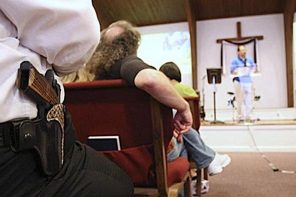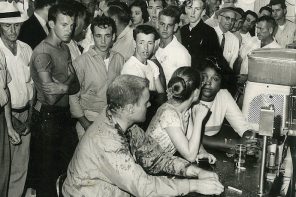On the stage at Ole Miss, Barack Obama stood a few feet from John McCain and debated the future of America. It was a debate between America’s first black major party nominee for president and his white opponent. It was an extraordinary cultural and political moment, one we must pause to contemplate.
The financial crisis, the typical political post-debate spinning, and the economic squeeze all of us feel from skyrocketing gasoline and utility costs all tend to overshadow this incredible circumstance.
In my grandfather’s lifetime, slaves in the South were still being instructed to “follow the Drinking Gourd” (the Big Dipper constellation) to the North to escape enslavement. Now, the old Kentucky farmer’s grandson is supporting an African American for president, a candidate ahead in the polls and clearly running a superior campaign—so good in fact that we can overlook the jaw-dropping history that’s being made.
As an iconic image, the stage at Ole Miss ought to rival Neil Armstrong’s first step on the moon. Except, when it comes to the issue of race, as a people we haven’t yet reached the heavens.
Many Americans of color (and, as always, poor whites, too) remain trapped in poverty, substandard education, crime, and quietly enforced institutional segregation. Sometimes the bright lights of the 21st century obscure these facts. But they obscure the night sky as well. It’s harder than ever to follow the Drinking Gourd. And too often when we try, seekers of freedom are still being chased by the hounds and scoundrels of bigotry, selfishness, and hatred.
What did we learn about the status of the presidential race—and America’s ongoing racial difficulties?
Looked at in terms of powerful cultural narratives, the images of Obama and McCain were almost archetypal. A confident black man calmly responds to an angry and uncomfortable older white man, who won’t look him in the eye, who is hobbled by his own prejudices. “They call me Mister Tibbs,” said Sidney Poitier as the detective Virgil Tibbs, to the belligerent Southern Police Chief, Bill Gillespie (Rod Steiger), in 1967’s Best Picture, In the Heat of the Night.
Over and over again, McCain said to Obama, “You don’t understand,” delivered in just the same tone Chief Gillespie used to mock Detective Tibbs’ detective work: “I’ll be damned,” said the dismissive chief, telling his deputies to put the naïve and not-understanding Tibbs on a train out of town.
But, to those viewers of both little and great political knowledge and interest, Obama very clearly did understand. And so, in the end, did the viewers, which is why post-debate snap polls gave the advantage to Obama.
The press went along somewhat reluctantly with these polls. Many tried to boost McCain, like Roger Simon of Politico, whose debate story was “Mac is Back.”
This is the “Great White Hope” phenomenon. It’s a term first used (by Jack London and others) in the early 20th century by enraged whites stunned that a black man, Jack Johnson, had become the heavyweight champion of the world. The press, most of them white, were surprised Obama won the nomination. They are still surprised. The fact that McCain didn’t make any quotable gaffes gives his boosters in the press a chance to praise him. Of course, they had to ignore the fact that he looked and acted like a grumpy old man tethered to the past and outclassed by his opponent.
Sarah Palin’s disastrous interview and McCain’s follies of last week, including his transparent grandstanding on the economic crisis that average Americans are not just reading about or watching from a distance—they can feel its consequences in their budgets and their burning stomachs—had already cost him support.
His debate performance did nothing to reverse his decline, and it probably accelerated it.
Still, it has been obvious for some time now that the McCain campaign plan—the spreadsheet where his team totes up enough votes to win—is based upon the GOP base and just enough so-called independents who also happen to be either quietly and unconsciously, or loudly and very consciously, racist.
These are the hounds and scoundrels referred to earlier. They are out there, just as they have been throughout America’s history.
But for all of the possible impact of race on the 2008 election, the issue is not much discussed. We’d rather not. The press uses euphemisms like “white, working-class Americans” to refer to those they know might vote against Obama because he’s black. It’s not because he’s not working class enough. It’s because he’s not white enough.
It’s also the case that Obama’s campaign has much to gain by trying to transcend old racial boundaries and knee-jerk antagonisms. He shouldn’t have to go back there (though his speech on race last spring was both a powerful message of freedom and equality delivered in the tones reminiscent of Martin Luther King Jr. and a transcendent, new message of hope). It’s our unfinished job, not his.
America’s unhappy history, its continuing struggles with race, its tendency to slip into fantasies of denial over unpleasantness of all kinds—these are all apparent when we look at the full tableau of campaign events last week.
The image was no longer the 160-year-old contest between Abraham Lincoln and Stephen Douglas in their classic presidential debates. In 2008, the forces of emancipation were represented not by an already free emancipator, but by one of the emancipated.
The scant notice given to that fact is, however, a sign that we have a long way to go. We have taken a giant step, but there are many necessary giant steps still to come. And the dogs are on our heels.



